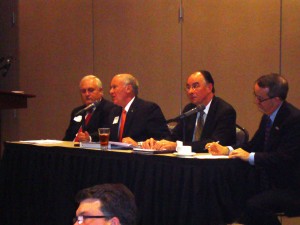Yesterday the D2 Center was pleased to join the Sherwood Foundation, Building Bright Futures and the City of Omaha to co-host the Multiple Pathways to Graduation Summit, held at Metropolitan Community College Swanson Conference Center on the Fort Omaha Campus.
The D2 Center’s own Greg Emmel served as emcee of the event, which brought together representatives from local school districts, post-secondary education, government and community agencies to tackle the needs of disengaged high school youth in Douglas and Sarpy counties.
Dr. Rachel Wise, Chief Operating Officer at Building Bright Futures, kicked off the day with an overview of data on the summit’s target population, including test scores and student issues such as absenteeism, juvenile justice, foster care, teen parents and homeless youth.
To keep the key reason for the event — youth — top of mind, we watched a powerful video created by Doug Walker from the Omaha Public Schools Career Center, featuring four Douglas and Sarpy county youth benefiting from — and succeeding with — alternative education options. With eye-opening honesty, these students shared their experiences overcoming obstacles that adults would struggle with, much less teens.
Following the video, Dr. Steven Edwards spoke on the importance of building relationships with students to help keep them engaged in an educational pathway.
Omaha Mayor Jim Suttle, Nebraska Commissioner of Education Dr. Roger Breed, and Metropolitan Community College President Randy Schmailzl participated in a panel discussion that focused on the importance of community involvement to address the needs of our students. Ultimately, as Mayor Suttle said, today’s students are our “future brain trust” and an investment in our students is an investment in our city’s and society’s future.
Andrew Moore, Senior Fellow with the National League of Cities’ Institute for Youth, Education and Families, and Terry Grobe from Jobs for the Future facilitated afternoon small group discussions that centered on data analysis of out-of-school and off-track youth in the metro area, assessment of current “multiple pathways” offerings in the area, and brainstorming how school districts and community agencies can work together to meet student needs. The charge for the day was to consider: as a community, what can we do next? How can we work together to increase educational pathway options for our students?
Here at the D2 Center we’ll be partnering with our co-hosts to compile all recorded small group action steps and send out to summit attendees. Yesterday was just the beginning in a long-term dialogue we hope to continue in our community to address the needs of disengaged youth.
A big thank you to everyone who helped plan and organize the event and to those who attended and participated. We value your voices!
For more summit coverage, see Mayor Suttle’s press release.
Below is the definition of “multiple pathways to graduation” used to guide the day, along with the goals of yesterday’s summit.
Multiple Pathways to Graduation Definition
Multiple Pathways to Graduation exist both within and beyond traditional school settings and provide viable options for disengaged, off-track and out-of-school youth to help them achieve a diploma and become college and career ready. These rigorous credit-bearing programs include but are not limited to creative and targeted approaches, community partnerships, innovative use of teaching methods and technology, flexible scheduling, low student/teacher ratios, career and post-secondary opportunities, and connections to community support services.
Multiple Pathways to Graduation Summit Goals
- Outline current high school completion options for disengaged, off-track, and out-of-school youth ranging from alternative options available within traditional high schools to options outside traditional high schools.
- Identify current needs of disengaged youth.
- Define gaps that exist between the need and current capacity to address the need.
- Foster multiple pathways to graduation opportunities in the metro area and identify specific program concepts, either existing or new, that fit within a collaborative approach.
- Identify next steps to improve high school completion rates.
